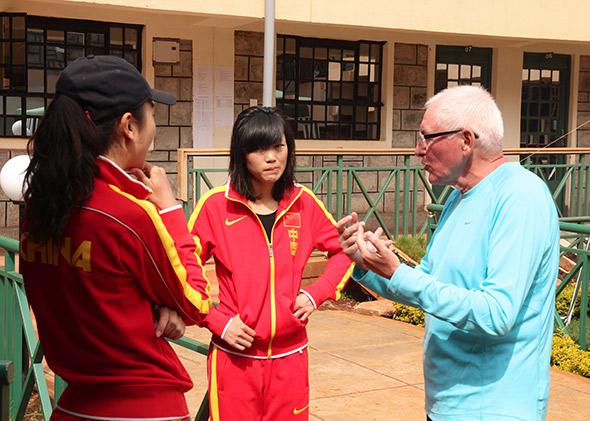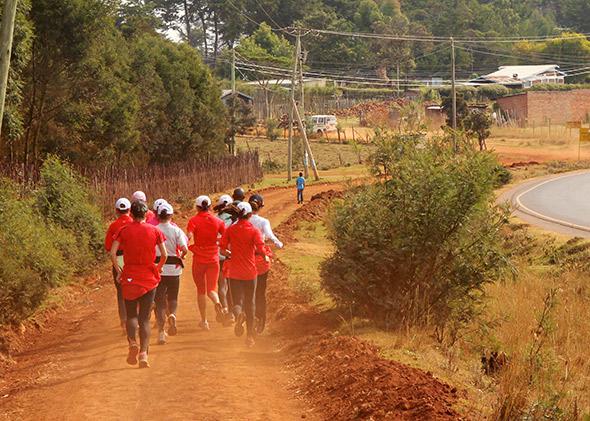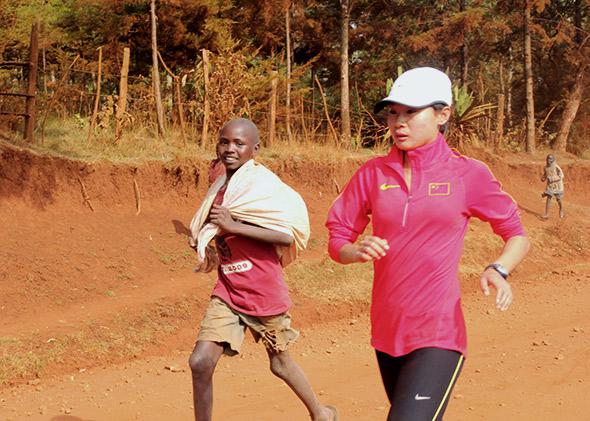Each Friday, Roads & Kingdoms and Slate publish a new dispatch from around the globe. For more foreign correspondence mixed with food, war, travel, and photography, visit their online magazine or follow @roadskingdoms on Twitter.
ITEN, Kenya—The morning air is crisp as the minivan plods down a red clay road, trailing the pack of runners as they head toward the escarpment, past schoolchildren, cows, and simple mud huts, eventually doubling back through the center of Kenya’s pre-eminent running town.
Renato Canova, the man behind the wheel, has driven this route many times. One of the world’s most accomplished distance running coaches, the 69-year-old Italian has been working with Kenyan athletes since 1998 and now spends much of the year in the Kenyan rift, an area famous for minting world-class athletes in events ranging from 800 meters to the marathon.
As usual, Canova is animated as he follows the progress of the run, occasionally pulling even with the pack to critique an athlete’s form or offer encouragement. On this morning, though, there’s an added layer of complexity. As Canova shouts out in heavily accented English, a young interpreter named Anna Lin repeats the words in Mandarin, and Wang Bin, a Chinese Athletics Association administrator, yells out the window to the athletes.
These runners—Canova’s latest protégées—are 16 members of China’s national women’s middle- and long-distance running team, in the early stages of preparation for the 2015 World Athletics Championships, to be held in Beijing in August 2015. On this February morning, midway through a six-week stint in Kenya, it’s clear they have their work cut out for them.
“In this period they are not very strong, practically,” Canova tells me as he steers his Toyota TownAce alongside a runner who’s fallen off the pack, grabbing her side and wincing.
“Renato, she says she ate too much for breakfast,” Lin, sitting next to me in the back seat, translates, referring to the athlete who ate fried eggs and sausage less than an hour before the run.
Canova appears both exasperated and amused. “What does she think to eat a breakfast like this?” he asks Lin. “She is missing out on good training.”

Courtesy of Jon Rosen
Canova’s newest athletes might be forgiven if they appear to be in over their heads. Despite being China’s best young runners, their credentials are unimpressive in a town known as the Home of Champions, where thousands of Kenyan athletes—including Olympic gold medalists, world record holders, and past winners of Boston, New York, London, and dozens of other major marathons—can be found plying the dirt roads every morning.
Overlooking the Kerio Valley, Iten has several attributes that make it an ideal spot for training: a temperate climate, soft dirt roads and forest paths, and an altitude—7,500 feet—that falls within the “sweet spot” defined in David Epstein’s 2013 book The Sports Gene. Epstein argues that training between 6,000 feet and 9,000 feet helps stimulate an athlete’s production of red blood cells, and therefore aerobic capacity, while still allowing for vigorous training.
The town also lies at the heart of territory inhabited by the Kalenjin, a community of several closely related traditionally pastoralist tribes renowned for its distance running prowess. Though the Kalenjin represent just 12 percent of Kenya’s population, the group accounts for nine of Kenya’s 10 all-time fastest male marathoners, and seven of its 10 all-time fastest women—a dominance that extends down through other long and middle distances in the world’s most decorated endurance running nation.
Although no single factor is responsible for this success, studies have shown that the Kalenjin, as a group, have several physical attributes that lend to biomechanical efficiency, including thin lower legs and a high leg length to torso ratio. More likely to be born with frames conducive to distance running, Kalenjin children are thought to benefit aerobically by growing up at altitude and—because many live in rural locations—commonly walking or running long distances to school. Given the Kalenjin running tradition, and the prospect of financial rewards for those who make it to the top, many pursue the sport with the aim of escaping poverty—which is acute enough in the Kenyan rift to remain a motivating factor, yet not so acute that widespread malnutrition hinders the development of young athletes.
It is in this context that Iten, along with the larger neighboring town of Eldoret, has become a magnet for aspiring athletes from Kenya and beyond. Some—like Wilson Kipsang, a former farm equipment salesman who began training seriously only in his mid-20s and eventually set the marathon world record—will find riches. But most will struggle. Take Simeon Lelel, an Eldoret native who Canova has hired as a pacemaker for the Chinese women. As we chat after the morning workout, Lelel tells me his marathon personal best is 2:16, which despite being run in Nairobi at an altitude of 5,500 feet is still a time that would rank among the top 20 or 30 performances run any given year by U.S. men. In Kenya, though, this barely qualifies him as a serious athlete.
So Lelel supports himself with occasional casual labor and other odd jobs, including his gig as a pacemaker, which lasts the six weeks the Chinese are in town. Lelel tells me he’s thrilled to have the opportunity, though it won’t exactly bring him material comforts. Most of the money he’ll use to help pay his relatives’ medical bills and school fees.
“My family is very poor,” he says, adding that he rarely eats anything besides ugali, a cornmeal paste, and steamed sukuma wiki greens, both Kenyan staples. “Sometimes getting food is a problem.”
The world inhabited by the athletes Lelel paces has little in common with his own, as well as that of international stars like Kipsang, now the owner of Iten’s Keellu Resort Hotel, where Canova’s Chinese athletes are staying. Although most of the women were born in rural areas, Canova tells me, all were recruited as children to join special sport schools, and they are effectively employees of the Chinese state, receiving monthly salaries from their respective provinces.
Unlike most Kenyans, their primary motivation is not the prospect of financial gain, but national recognition, earned through success at China’s National Games, held once every four years, and through international competitions like the Olympics and the biannual World Championships. Although athletes performing well at these events sometimes receive apartments, cars, or other perks, only China’s biggest stars—like Liu Xiang, the former 110-meter hurdles world record holder who has several lucrative endorsements—can expect to become wealthy through athletics.
Canova, who was hired by China’s Athletics Association last year, is slowly trying to change this, encouraging what he calls an “idea of professionalism.” The notion is that some team members, like most of the world’s elite track and field athletes, will compete for prize money on this summer’s European athletics circuit even as they train for next year’s World Championships and the 2016 Olympics in Rio de Janeiro. Ultimately, with the right training and incentives, Canova believes that China, by virtue of its size alone, should be able to produce several internationally successful athletes—even if the average Chinese may not be engineered for running like the average Kalenjin. “It’s never a problem of pure talent,” he says. “When you speak about a country with almost one and a half billion people, there is talent for everything.”
China’s current crop of female athletes has a precedent for success. In 1993, a team of peasant women from northeastern China’s Liaoning province, led by a fiery chain-smoking coach named Ma Junren, won six medals at the World Championships, in Stuttgart, including golds in the 1,500 meters, 3,000 meters, and 10,000 meters. The following month, members of the “Ma Family Army” set world records in all three events at the Chinese National Games in Beijing. One athlete, a 20-year-old named Wang Junxia, ran the 10,000 meters in 29:31—42 seconds faster than the previous world record.
Although no members of Ma’s 1993 squad ever failed a drug test, their extraordinary success led to a host of doping allegations, which Ma countered by citing the team’s grueling high-altitude training and its use of natural tonics, such as turtle’s blood and caterpillar fungus. Eventually, though, six Ma-coached athletes, including onetime 5,000-meters world record holder Dong Yanmei, would fail tests for the blood-boosting substance erythropoietin and be dropped from China’s national team before the 2000 Olympic Games in Sydney. By then, Ma had come under scrutiny for other unseemly coaching tactics, including confiscating athletes’ winnings and physically abusing runners who were “lazy” or disobedient.
Canova, whose affability stands in stark contrast to Ma’s explosiveness, refuses to speculate on the use of drugs by Wang and her contemporaries, arguing that their success was primarily the result of a brutal training regimen that saw the women run as many as 175 miles per week, often at high intensity. This hard work, he tells me, was largely motivated by China’s bid to host the 2000 Olympics in Beijing, which it narrowly lost to Sydney before later securing the games in 2008. “There was this idea, if you produce top results, and because of these top results China can have the Olympics, you become a national hero,” Canova tells me. “Never before in the world was there someone working so hard. They had this incredible motivation.”

Courtesy of Jon Rosen
Today, in advance of the 2015 World Athletics Championships in Beijing, as well as the 2015 World Cross Country Championships, to be held next March in the southwestern city of Guiyang, Chinese officials and their athletes have a renewed focus on running. This time, though, in a country far more open than it was in the early 1990s, the federation has decided to look outward, abandoning turtle’s blood and attempting to learn from the Kenyans, the sport’s masters. Despite significant Chinese investment in Kenya, Wang, the team administrator, insists his team’s presence in Iten is not related to politics but is instead a question of clean air and soft dirt roads—increasingly rare at home.
The decision to train here (for now, only during winter months) is also linked to Canova. A native of Turin, Italy, Canova began coaching members of the Italian national team at 24, rising to become technical and scientific director of the Italian Athletics Federation. Eventually, he turned his attention to Kenyans, coaching several world champions and world record holders, and between 2003 and 2010 serving as the national coach of Qatar, which bought its way to athletics success by offering citizenship and regular salaries to dozens of Kenyan athletes. Unlike many coaches, Canova gained a reputation for openly sharing his training programs, which were transmitted by word-of-mouth among legions of aspiring Kenyan athletes who didn’t have coaches, as well as through Canova’s own posts on LetsRun.com, a leading running website.
As a result, Canova’s training philosophy has played an important role in shaping the sport’s recent evolution—in particular, a remarkable transformation in the men’s marathon that has occurred over the past decade. In 2003, the Kenyan great Paul Tergat accomplished what was described as a “quantum leap” in the event when he won the Berlin Marathon in 2:04:55, taking 43 seconds off the previous world record. Since then, 24 men—all Kenyan or Ethiopian—have run faster, led by Kipsang’s 2:03:23. Although doping allegations have begun to circulate, Canova attributes the marathon revolution to two main factors: the decline of prize money in track events, which has encouraged athletes to focus on the marathon and other longer road races earlier in their careers, and changes in training methodology, largely facilitated by Canova himself, that stress fewer overall long runs (training sessions of more than 30 kilometers), but more runs that are both long and fast.
Whatever the cause, the results have been impressive.
“Ten years ago, if you ran 2:06 or 2:07, you were the top athlete,” says Duncan Kibet, who won the 2009 Rotterdam Marathon in 2:04:27, then a Kenyan national record. “Our time now, this is a digital era. We changed from analog to digital tech.”
Notably, though, this same transformation has not occurred in the women’s marathon, where Briton Paula Radcliffe continues to hold the world record of 2:15:25 she set in 2003, and six of the top 10 all-time performances were run in 2005 or earlier. As Canova tells me, this is partly explained by the fact that female running is less common among many rural Kenyan and Ethiopian households, which means there are fewer Kenyan and Ethiopian women than men racing at an elite level. With less competition at the top, the earning potential of an elite Kenyan woman tends to be much greater than that of her male counterparts, and outside countries, like China, stand a better chance in women’s distance events than they do in men’s.
It is largely for this reason that China’s federation has decided to focus mainly on its female runners, who, despite lacking the accolades of their Ma-coached predecessors, have managed some recent international success. At the 2004 Olympics in Athens, a Chinese woman, Xing Huina, won gold in the 10,000 meters, edging out two Ethiopians. Five years later, at the 2009 World Championships in Berlin, Bai Xue, a 20-year-old from the northeastern province of Heilongjiang, won gold in the women’s marathon, becoming the youngest champion in the event’s history.
Although Bai, now 25, has struggled with injuries, she is training to compete in Beijing in 2015 and is easily the most accomplished athlete in Canova’s group. Though shy, she agrees to chat following her afternoon workout, which featured 800-meter repeats on Iten’s new, exclusive, Tartan track. Insisting that she shower before we talk, she meets me in the courtyard of Kipsang’s hotel, sporting wet hair and a black down jacket. With Lin translating, Bai tells me about her career in athletics: how she left home for sports school at the age of 14 because her father thought she had talent, how her win in Berlin came as a complete surprise, how she’s inspired by all the accomplished athletes she sees along the roads of Iten.
Still, despite the many other female stars in town—Mary Keitany, Kenya’s national marathon record holder; Florence Kiplagat, world record holder in the half-marathon; even Radcliffe, who, at 40, is using Iten as a base to prepare for the 2015 London Marathon—Bai says she hasn’t actually spoken with any other top athletes. While she’d like the opportunity, she says she’s mainly focused on her teammates and their collective goal of reviving Chinese running.
When I ask what it will take for China to succeed, she surprises me with a word in English.
“Grandpa,” she says, before continuing in Mandarin. “The leadership of grandpa Renato, for sure.”
